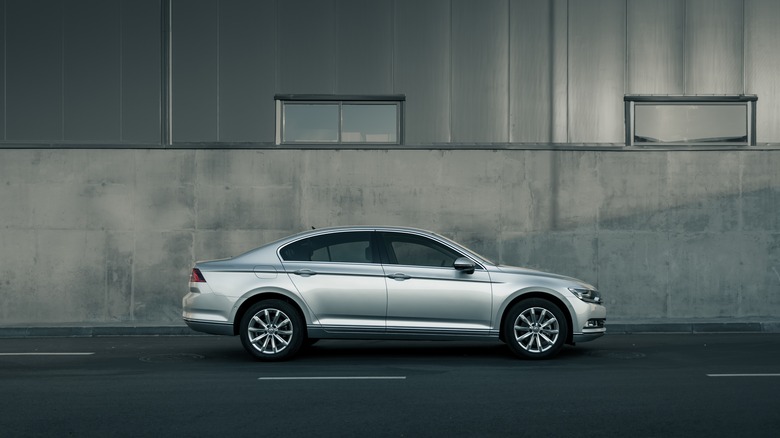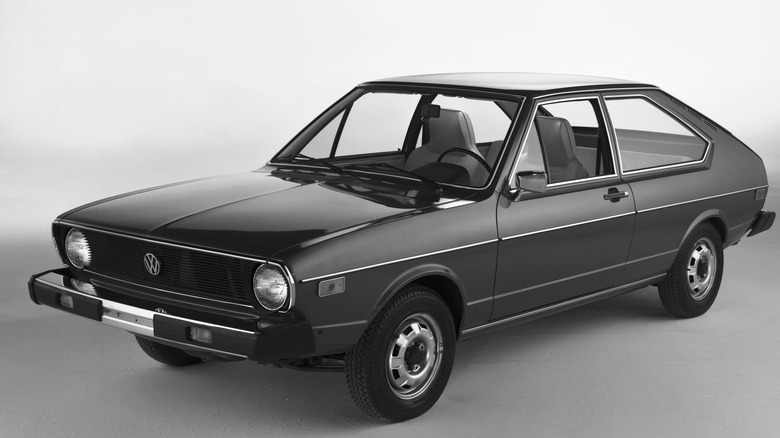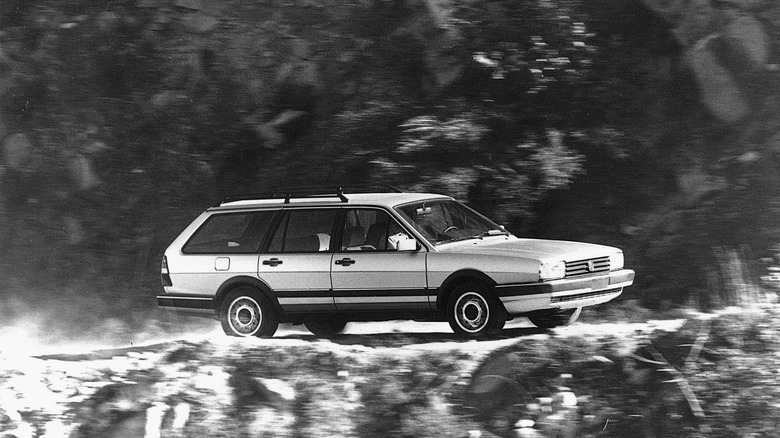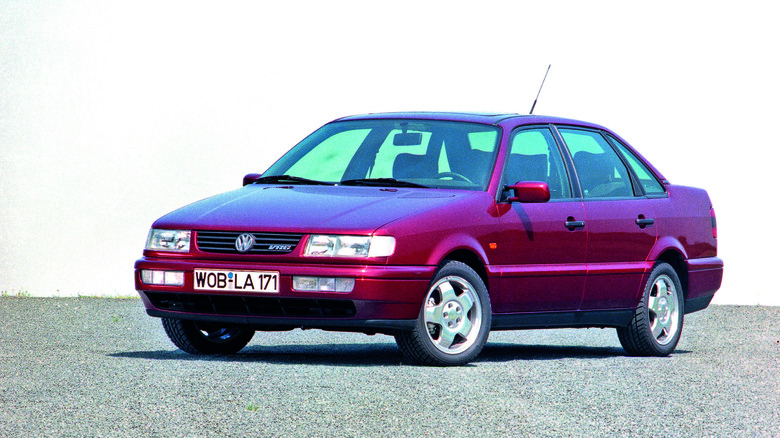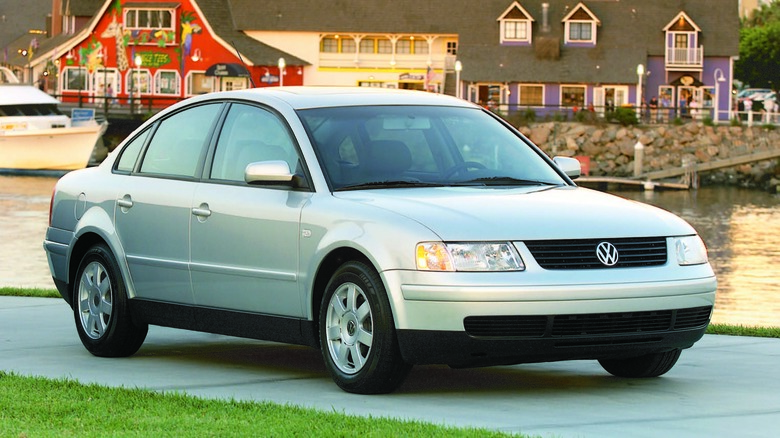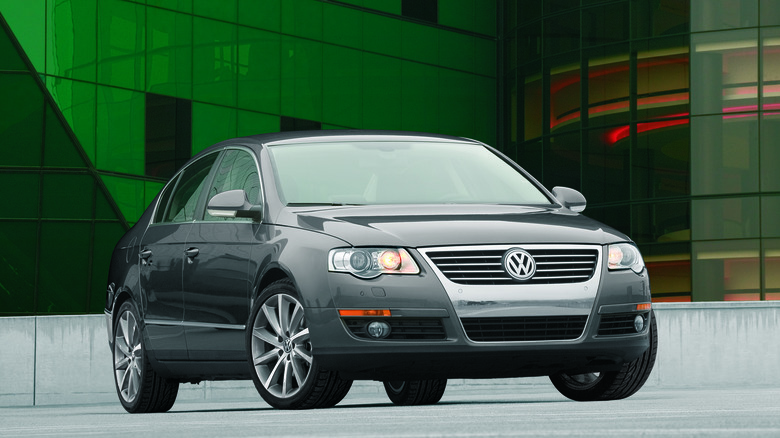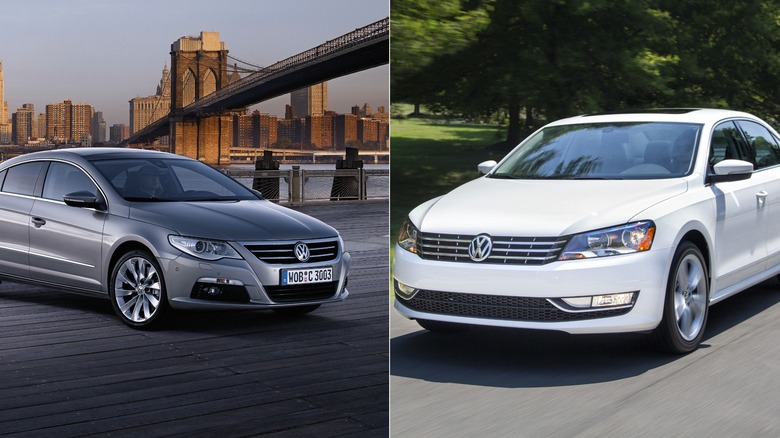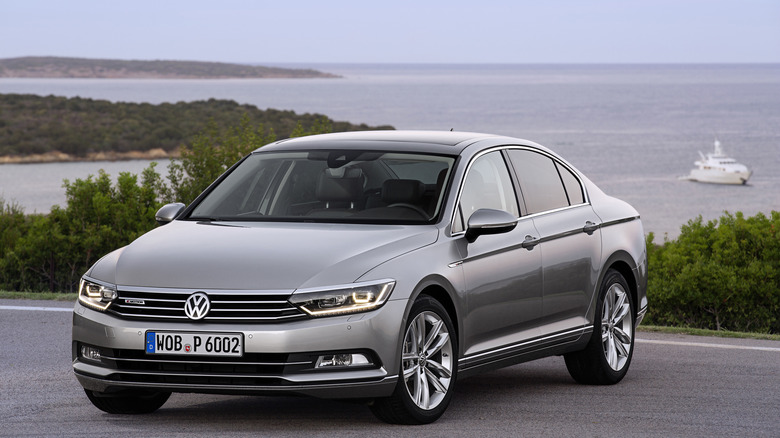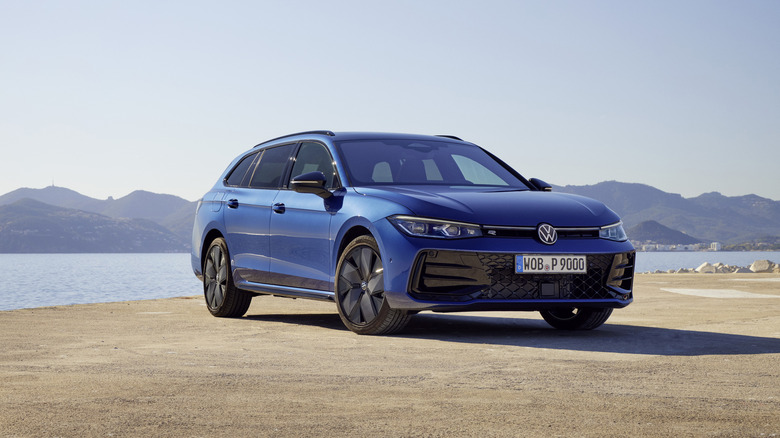The Evolution Of The Volkswagen Passat: From 1973 To Today
Volkswagen established itself long ago as one of the most notable players in the world of cars, with a high volume of sales and the distinction of being the primary choice for a lot of buyers, especially in Europe. The Wolfsburg-based automaker has a worldwide presence, and offers a little something for everyone in every market. VW and Euro enthusiasts continue to celebrate its icons, like the Beetle and the Golf, which itself just turned 50 years old in 2024.
Less loved, but still a perennial mainstay in the VW Group's history, is the Passat. The Passat is only a year older than the Golf, celebrating its 50th in 2023. First introduced in 1973, the Passat answered this question: What if the Golf was bigger and had more room? The first generation B1 Passat is definitely a far cry from the latest version, and the evolution of this iconic sedan is definitely one worth checking out.
Hand-Me-Downs From Audi: B1
While the Passat does answer the "Golf-as-a-large-family-car" question, that's not the full story. The original B1 Passat arrived in 1973, with an exterior design penned by the legendary Giorgetto Giugiaro. Thanks to that, the Passat bears a fairly strong resemblance to the Mk1 Golf, which went onto the market around the same time to replace the Beetle. However, one look under the bodywork would confirm that it was a totally different machine.
The B1 Passat borrowed its platform from the Audi Fox, and as a result, bears a slight resemblance to that car as well. The B1's engine was mounted longitudinally, though it was still front-wheel drive, a layout that Audi still uses today. The powertrain lineup was relatively small, offering up a carbureted four-cylinder with 74 hp, and later a 78 hp version with fuel injection. A diesel version was also available, for low-end torque and fuel economy bragging rights. In North America, the name Passat was shunned in favor of Dasher, which in itself received larger bumpers and different headlights. B1 Passat production ended in the early 1980s.
A Steady Evolution: B2
Introduced in Europe in 1980, and eventually arriving in North America for model year 1982, the second generation Passat was more of an evolution than a revolution — at least, in terms of styling. The B2 Passat was a whole lot bigger than the B1, resulting in much more room for people and their things. Despite its evolutionary styling, the bodywork slowly got more boxy, keeping with the tune of 1980s automotive design. Comparing the two side-by-side, the B1 almost looks archaic.
There was an all-new platform here as well. It was still from Audi, but this time VW used a version of the Audi 80's platform. The use of this platform allowed VW to give the B2 Passat, for the first time in its life, AWD. Syncro, as VW called it, was essentially a rebadged version of Audi's Quattro system. Audi began incorporating Quattro into all of its cars during the 80s after the incredible success of Quattro rally car.
Once again, North America did not get the B2 as a Passat, or even a Dasher. This time, Volkswagen's large family car reached the U.S. and Canada as the Quantum. It remained in production until 1988, already establishing itself as one of the premiere choices for family car buyers. After this, however, things changed for the Passat quite drastically.
No More Audi Roots: B3 and B4
Some things eventually have to come to an end, even if they are Audi-sourced underpinnings. That was exactly the case when the B3 Passat hit the market in the late 80s and early 90s. Gone was the Audi Fox architecture and longitudinal engine layout, and in its place came an enlarged version of the Golf platform. This meant the engine was now mounted transversely, and it also meant VW could use its own AWD system, instead of borrowing Audi's Quattro, though VW still called it Syncro. It also meant sharing components with VW's wonderful sporty 90s coupe, the Corrado.
Along with that, the styling was thoroughly revamped both inside and out. The earlier B3 Passats omitted the front grille pretty much entirely, decades before electric cars made that cool. The B4 Passat, which came along in the mid 90s, reintroduced the grille, but it's important to note that the B4 was not an entirely new generation. Similar to the Mk5 and Mk6 Golf, the B4 was a heavily reworked version of the B3.
The powertrain lineup also completely changed, offering some much more powerful units befitting a large family car. The B3 Passat generation was the first to receive VW's innovative VR6 engine, which in itself revolutionized installing a larger engine in a FWD automobile. Finally, the B3 and B4 Passat kept the Passat name even in North America.
Full Steam Into The Upmarket: B5
Now it's time for the finest examples of the breed. The B5 Passat, launched in 1998, took VW's large family car to the next level. Despite only using them a grand total of... once, VW decided the Golf underpinnings simply weren't cutting it, and moved the new B5 Passat back to an Audi architecture. Specifically, the B5 was based on the same platform that underpinned the B5 Audi A4, hence the two cars sharing the internal codename.
This meant, once again, a longitudinal engine layout, and brought a whole lot more sophistication to the Passat. Major strides were taken to ensure the interior was a quality place to spend time, and the B5 Passat also introduced some pretty impressive technology and features. It kept the familiar powertrains, which included the 1.8 four pot and the 2.8 V6 in North America, as well as the highly celebrated beacon of bulletproof engines, the 1.9 TDI four-cylinder.
The most noteworthy aspect about the B5 Passat is VW doubling down on the philosophy that the Passat is a true flagship. It got a plusher interior, and one of the most unique, but also one of the most troublesome powertrains in recent history: a 4.0-liter W8, creating the Passat W8 4Motion. It was meant to compete with luxury sports sedans, and that didn't go so well. While the B5 Passat has been lost to time for the most part, it's considered automotive royalty in Southeast Europe, especially the Balkans.
The Last Europe-Sourced Passat: B6
In 2005, the B5 Passat was retired, making way for the all-new B6 Passat in 2006. Volkswagen couldn't really seem to make up its mind when it came to the platforms, as the B6 Passat would, once again, jump back to VW's own platform with a transverse engine layout, sharing virtually nothing with the Audi A4 of the same time period. On the outside, VW gave the Passat an exterior that still looks modern today.
With bold, sharp lines, and all-LED taillights on all models, the B6 Passat definitely carries some authority. It was also a few inches larger than the model it replaced, thus giving it more room on the inside. Thanks to the transverse engine layout, there couldn't be another W8, but the powertrains on offer were very solid. In place of the W8, VW gave the B6 Passat a 3.6-liter VR6.
This engine was available in North America, but Europe got a tuned version in the Passat R36. This would be the holy grail for the B6 Passat, and it was available as both a sedan and a wagon. This would be the last Passat sold in North America to come from Europe, as Volkswagen set about creating something that appealed more to the American buyer afterward. The fruits of that labor would be seen in the following generation.
New Mid-Size Sedan and A Comfort Coupe
When the B6 Passat ran its course, Volkswagen introduced North America (and China) to a brand-new Passat, the result of its New Midsize Sedan project. Despite the visual similarities to what Europeans called the B7 Passat, the NMS Passat was very different. For one, it was significantly larger than any Passat that came before it, putting it neatly in North America's mid-size sedan segment, which was dominated by the likes of the Toyota Camry and Honda Accord.
Sadly, the NMS Passat lost the option of AWD, and the interior wasn't quite as upscale as most people had come to expect from VW. It did offer the option of a VR6 engine, however, as well as a turbodiesel — Well, until the company's infamous Dieselgate scandal happened. The closest thing to the B7 Passat that North Americans got was the Passat CC, later renamed to just the CC. While it shared the same platform as the B6 and B7 Passat, the CC was more stylish and aimed at more upscale buyers.
Being more closely related to the B7 Passat, the CC was also more luxurious and plush on the inside. Unfortunately, it didn't really strike a chord with Americans, and VW pulled the plug. Eventually, in 2022, VW called it quits on the NMS Passat as well. While the Arteon is technically taking its spot in the lineup, Volkswagen never really followed up with a proper replacement, ending the iconic family car's legacy in North America.
The Final Sedan: B8
While North America got the NMS Passat, 2015 brought Europeans an all-new B8 Passat, based on the new and improved MQB platform. This platform also underpinned the Golf, the Audi A3, the Skoda Superb, and countless other VW Group vehicles. The B8 Passat's styling was, once again, a cautious evolution, though it was certainly more distinctive. It was also a technology frontrunner, as the first Volkswagen with a fully digital instrument cluster.
Sadly, it lost the six-cylinder engine, opting instead for a group of proven VW Group four-cylinders, including a version with the EA888 2.0-liter turbo, essentially the unit that was doing service in the Golf GTI and Golf R. 4Motion AWD was offered, along with a massively practical wagon version, as was always the case with the European Passat. This represents one of the absolute peaks of the Passat nameplate, and it was also the first generation to introduce a plug-in hybrid version in the Passat GTE.
While most Europeans didn't realize it, this would end up being the last ever Passat generation to be offered as a... sedan?
The Last Wind: B9
That's right. In a rather surprising move, Volkswagen has chosen to offer the latest B9 Passat, introduced back in 2023 for model year 2024, only as a Variant station wagon. While its platform sibling, the Skoda Superb, gets a liftback version, the Passat will be wagon only for Europe. As Volkswagen prepares for an all-electric future, the ID.7 is poised to take the Passat's position in the lineup, and it's very likely this will be the last ever Passat powered by internal combustion.
Volkswagen's new wagon comes with a host of gasoline and diesel power units, all of them being paired exclusively with an automatic transmission, the B8 being the last one to offer a manual. The B9 also brings along a much improved plug-in hybrid that promises 62 miles of EV-only range, which is very impressive. On the inside, it's very similar to the ID.7 and VW's other EVs, which means a giant infotainment screen, a bunch of cool new features, and the infamous touch-sensitive controls that exactly no one likes.
If this really is the final Passat generation, it's an excellent way for the legacy to end. But we will definitely miss it.
